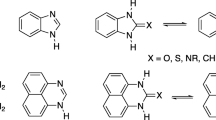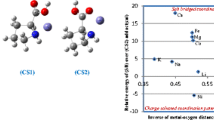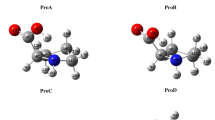Abstract
The saturated ring and secondary amine of proline spawn equilibria between pyrrolidine ring puckers as well as peptide bond isomers. These conformational equilibria can be modulated by alterations to the chemical architecture of proline. For example, Cγ in the pyrrolidine ring can be replaced with sulfur, which can be oxidized either stereoselectively to yield diastereomeric S-oxides or completely to yield a sulfone. Here, the thiazolidine ring and peptide bond conformations of 4-thiaproline and its S-oxides were analyzed in an Ac–Xaa–OMe system using NMR spectroscopy, X-ray crystallography, and hybrid density functional theory. The results indicate that the ring pucker of the S-oxides is governed by the gauche effect, and the prolyl peptide bond conformation is determined by the strength of the n → π* interaction between the amide oxygen and the ester carbonyl group. These findings, which are consistent with those of isologous 4-hydroxyprolines and 4-fluoroprolines, substantiate the importance of electron delocalization in amino acid conformation.





Similar content being viewed by others
References
Aitken RA, Mesher STE, Ross FC, Ryan BM (1997) Effect of added benzoic acid on the phase-transfer catalysed permanganate oxidation of organosulfur compounds. Synthesis 7:787–791
Benzi C, Improta R, Scalmani G, Barone V (2002) Quantum mechanical study of the conformational behavior of proline and 4R-hydroxyproline dipeptide analogues in vacuum and in aqueous solution. J Comput Chem 23:341–350
Choudhary A, Raines RT (2009) A donor–acceptor perspective on carbonyl–carbonyl interactions in proteins. In: Lebl M (ed) Breaking away: the proceedings of the twenty-first American peptide symposium. Prompt Scientific Publishing, San Diego, CA, pp 347–349
Choudhary A, Gandla D, Krow GR, Raines RT (2009) Nature of amide carbonyl–carbonyl interactions in proteins. J Am Chem Soc 131:7244–7246
DeRider ML, Wilkens SJ, Waddell MJ, Bretscher LE, Weinhold F, Raines RT, Markley JL (2002) Collagen stability: insights from NMR spectroscopic and hybrid density functional computational investigations of the effect of electronegative substituents on prolyl ring conformations. J Am Chem Soc 124:2497–2505
Eberhardt ES, Panasik N Jr, Raines RT (1996) Inductive effects on the energetics of prolyl peptide bond isomerization: implications for collagen folding and stability. J Am Chem Soc 118:12261–12266
Fischer E (1906) Untersuchungen über Aminosaüren, Polypeptide und Proteine. Ber Deutsch Chem Ges 39:530–610
Fischer FR, Wood PA, Allen FH, Diederich F (2008) Orthogonal dipolar interactions between amide carbonyl groups. Proc Natl Acad Sci USA 105:17290–17294
Glendening ED, Badenhoop JK, Reed AE, Carpenter JE, Bohmann JA, Morales CM, Weinhold F (2001) NBO 5.0. Theoretical Chemistry Institute. University of Wisconsin-Madison, Madison, WI
Goodman M, Niu GC-C, Su K-c (1970a) Conformational aspects of polypeptide structure. XXXII. Helical poly[(S)-thiazolidine-4-carboxylic acid]. Theoretical results. J Am Chem Soc 92:5219–5220
Goodman M, Su K-c, Niu GC-C (1970b) Conformational aspects of polypeptide structure. XXXII. Helical poly[(S)-thiazolidine-4-carboxylic acid]. Experimental results. J Am Chem Soc 92:5220–5222
Gorres KL, Raines RT (2010) Prolyl 4-hydroxylase. Crit Rev Biochem Mol Biol 45:106–124
Gorres KL, Edupuganti R, Krow GR, Raines RT (2008) Conformational preferences of substrates for human prolyl 4-hydroxylase. Biochemistry 47:9447–9855
Higashijima T, Tasumi M, Miyazawa T (1977) 1H Nuclear magnetic resonance studies of N-acetyl-l-proline N-methylamide. Molecular conformations, hydrogen bondings, and thermodynamic quantities in various solvents. Biopolymers 16:1259–1270
Hinderaker MP, Raines RT (2003) An electronic effect on protein structure. Protein Sci 12:1188–1194
Holmgren SK, Taylor KM, Bretscher LE, Raines RT (1998) Code for collagen’s stability deciphered. Nature 392:666–667
Improta R, Benzi C, Barone V (2001) Understanding the role of stereoelectronic effects in determining collagen stability. 1. A quantum mechanical study of proline, hydroxyproline, and fluoroproline dipeptide analogues in aqueous solution. J Am Chem Soc 123:12568–12577
Kern D, Schutkowski M, Drakenberg T (1997) Rotational barriers of cis/trans isomerization of proline analogues and their catalysis by cyclophilin. J Am Chem Soc 119:8403–8408
Lesarri A, Cocinero EJ, López JC, Alonso JL (2005) Shape of 4S- and 4R-hydroxyproline in gas phase. J Am Chem Soc 127:2572–2579
Liang G-B, Rito CJ, Gellman SH (1992) Variations in the turn-forming characteristics of N-acyl proline units. Biopolymers 32:293–301
Matsuzaki T, Iitaka Y (1971) The crystal structure of acetyl-l-proline-N-methylamide. Acta Crystallogr B27:507–516
Melis C, Bussi G, Lummis SCR, Molteni C (2009) Trans–cis switching mechanisms in proline analogues and their relevance for the gating of the 5-HT3 receptor. J Phys Chem B 113:12148–12153
Milner-White JE, Bell LH, Maccallum PH (1992) Pyrrolidine ring puckering in cis and trans-proline residues in proteins and polypeptides. J Mol Biol 228:725–734
Nachtergaele WA, Anteunis MJO (1980) Ring conformational aspects of cis- and trans-N-acetyl-4-carbomethoxy-1,3-thiazolidine-1-oxide. Bull Soc Chim Belg 89:749–758
Panasik N Jr, Eberhardt ES, Edison AS, Powell DR, Raines RT (1994) Inductive effects on the structure of proline residues. Int J Pept Protein Res 44:262–269
Paulini R, Müller K, Diederich F (2005) Orthogonal multipolar interactions in structural chemistry and biology. Angew Chem Int Ed 44:1788–1805
Prabhakar YS, Solomon VR, Gupta MK, Katti SB (2006) QSAR studies on thiazolidines: a biologically priviliged scaffold. Top Heterocycl Chem 4:161–249
Shoulders MD (2009) Ph.D. thesis, University of Wisconsin-Madison
Shoulders MD, Kamer KJ, Raines RT (2009) Origin of the stability conferred upon collagen by fluorination. Bioorg Med Chem Lett 19:3859–3962
Tshuchishashi G-i, Mitamura S, Inoue S, Ogura K (1973) Asymmetric synthesis using α,β-unsaturated sulfoxides. A highly selective Michael reaction. Tetrahedron Lett 323-326
Ulshöfer R, Podlech J (2009) Stereoelectronic effects in vinyl sulfoxides. J Am Chem Soc 131:16618–16619
Weinhold F (1998) Natural bond orbital methods. In: PvR Schleyer, Allinger NL, Clark T, Gasteiger J, Kollman PA, Shaefer HF III et al (eds) Encyclopedia of computational chemistry, vol 3. John Wiley & Sons, Chichester, UK, pp 1792–1811
Weinhold F, Landis CR (2005) Valency and bonding: a natural bond orbital donor–acceptor perspective. Cambridge University Press, Cambridge, UK
Wendt M, Weinhold F (2001) NBOView 1.1. Theoretical Chemistry Institute. University of Wisconsin-Madison, Madison WI
Wittelsberger A, Keller M, Scarpellino L, Patiny L, Orbea-Acha H, Mutter M (2000) Pseudoprolines:targeting a cis conformation in a mimetic of the gp120 V3 loop of HIV-1. Angew Chem Int Ed 39:1111–1115
Zhu W, Gincherman Y, Docherty P, Spilling CD, Becker DF (2002) Effects of proline analog binding on the spectroscopic and redox properties of PutA. Arch Biochem Biophys 408:131–136
Acknowledgments
We thank C. N. Bradford, B. R. Caes, G. A. Ellis, and K. L. Gorres for contributive discussions. This work was supported by grant R01 AR044276 (NIH). K.H.P. was supported by a Mary Shine Peterson award.
Author information
Authors and Affiliations
Corresponding author
Rights and permissions
About this article
Cite this article
Choudhary, A., Pua, K.H. & Raines, R.T. Quantum mechanical origin of the conformational preferences of 4-thiaproline and its S-oxides. Amino Acids 41, 181–186 (2011). https://doi.org/10.1007/s00726-010-0504-8
Received:
Accepted:
Published:
Issue Date:
DOI: https://doi.org/10.1007/s00726-010-0504-8




